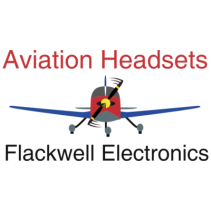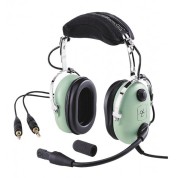Frequently asked Questions
Why is my headset earphones now only working on one side?
Many modern headsets now have Stereo capability but not many aircraft do. There is usually a small slider switch on the plug splitter box that switches from mono to stereo. If the switch is set to stereo and the headset used in a standard mono aircraft - only one earphone will work. So check the switch.
What are the different plug types that are used on aviation headsets?
Twin Plugs - the Mic plug is thinner than the Phono plug. These are commonly used on most general aviation aircraft as well as most Airliners. UK NATO plug is a short brass plug with 4 contact rings commonly used on all UK Military aircraft and some helicopters. (Often denotes military spec headset that is not useable on GA Aircraft) USA NATO plug (U174/U) Similar to the UK NATO plug but has a silver nickel finish to contacts and a smaller body diameter. Used on many helicopters and ground crew headsets * Note. The U174/U plugs on the ground crew headsets are wired differently to standard aircraft U174/U plugs! 5 pin XLR plugs are nickel or black bodied metal plugs with 5 small pins arranged in a semi-circle. Most commonly used on the Airbus range of Airliners.
What's the difference between Civil specification headsets and Military types?
There are 3 main types of headset impedance specifications - none are interchangeable with each other without specific adapters / converters etc. (available from Flackwell Electronics) The USA Mil headset is difficult to convert to civil spec, the NATO headset can be converted to civil spec with an adapter box. You cannot economically convert civil spec headsets to military spec. Even after conversion you may still encounter compatibility problems 1.Civil Specification headset - 600ohm total earphone impedance. Microphone is "100 ohm carbon level" which is achieved in a variety of ways - old style carbon mic. Amplified dynamic mic or amplified electret mic - as per David Clark headsets. 1.75m straight cable with twin plugs. 2.NATO spec Military headset - 150 ohm total earphone impedance. Microphone is a 150-ohm dynamic microphone. UK NATO plug. 3.USA Military Specification - 9.5-ohm total earphone impedance. Microphone is a 5-ohm dynamic microphone. USA U174/U NATO plug.
How do I calculate earphone total impedance?
Earphone impedance calculations; you can wire the earphones in series or parallel. Wiring earphones in series doubles the total impedance of the earphones i.e. 300 ohm earphones in series = 600 ohm total impedance. Wiring earphones in parallel halves the total impedance of the earphones i.e. 300 ohm earphones in parallel = 150 ohm total impedance. Phasing becomes important for best performance which ever way they are connected. Also parallel connection provides a fail safe as if one side was to go open circuit the remaining side will still function. When wired in series if one side goes open circuit both sides fail to operate, similar to Christmas tree lights.
What Microphone types are available?
There are a variety of different microphone designs…
"Dynamic" microphones are essentially a loud speaker in reverse - you speak into a small cone / membrane which has a coil attached to it that moves in the magnetic field of a permanent magnet in the element. The cone moves in time with the voice input and the coil moving in the magnetic field has a variable signal induced into it by the magnetic field of the magnet. This varying signal becomes the mic output signal / voltage from the microphone.
"EM or Electromagnetic mics" - are similar to a Dynamic mic but use a rocking armature system for the coil / magnetic assembly.
"Carbon" mics are made by enclosing carbon granules within a flat capsule. A small voltage is applied to the element. When a voice input moves the capsule diaphragm, compressing the granules the effect is to vary the voltage signal through the element. This becomes the mic output signal.
Electret Mic elements are a modern design based on capacitance. A charged plate has a voice diaphragm in front of it - as the voice moves the diaphragm in the field of the plate, it changes the capacitance - this variance is picked up by a 'FET' amp, which is connected behind the plate. A small voltage is supplied to the FET amp for it to work and to output a signal as the mic output.
Dynamic and EM mics do not require a voltage feed to them to work - they output their own voltage signal. Carbon and Electret mics need a supply voltage from the main equipment to enable them to work. This is why the different mic types are not interchangeable.
Dynamic, EM and Electret mics have a small output signal level, whilst Carbon mics have a much larger output signal.
Microphones used in aviation - Military microphones tend to be Dynamic types.
Civil spec microphones were historically based on the Carbon Mic element. But as dynamic and Electret mics have a much nicer signal output in terms of noise cancelling and audibility, modern microphone development has lead to the development of amplified Electret and amplified Dynamic mics that mimic the old carbon mic output levels to match the requirements of the Civil spec avionics.
Virtually all modern aviation headsets use amplified Electret mics (to carbon level) but are often incorrectly described as just "Electret mic". Eg: David Clark H10-13.4. There are also some amplified Dynamic headsets eg: David Clark H10-30 and some Peltor headsets.
Civil spec microphones tend to have the amplifier built into the mic element (like the David Clark M4 or M7 mics) or some headsets have the amplifier in the headset's ear shell (like most Peltors).
Are they interchangeable?
As a general rule you can amplify a Military spec microphone to civil spec carbon level, with the use of a suitable amplifier in line. This is usually a plug in box in the downlead of the headset. These are commonly used by Warbird owners using military helmets etc in an aircraft fitted with modern radios - these are available from Flackwell Electronics.
Civil spec mics cannot be used in a military system without an electronic interface box and separate battery power supply to power the mic element. These are not commonly available or used but could be "custom made" by Flackwell Electronics if required.
Microphones used in other equipment?
Most modern communications equipment tends to use the Electret mic element (unamplified) as the microphone of choice. They are small, lightweight, cheap and offer good noise cancelling audibility. Eg: PCs, PMR Radios and Mobile Phones.
Aviation headsets with their high output carbon mics are not always suitable for non-aviation applications without some interface matching. Conversely, headsets for non-aviation uses cannot be used in aircraft applications without amplifiers in line.



